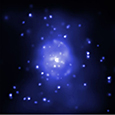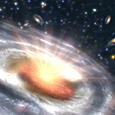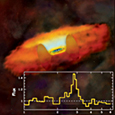A California-based company founded in 2003,Artificial Development, is developing neural network cognitive systems and wants to introduce "the first 5th Generation computer to the world." According to e4engineering.com, the company recently completed a representation of a functioning human brain. This project, named CCortex, has vast ambitions. The company hopes that their "software may have immediate applications for data mining, network security, search engine technologies and natural language processing." This software runs on a Linux cluster with 1,000 processors and the CCortex system has 20 billion neurons and 20 trillion connections. The company says this is "the first neural system to achieve a level of complexity rivaling that of the mammalian brain."
 | Here is a picture of the CCortex Linux cluster which has 500 nodes for 1,000 processors, 1 terabyte of RAM, and 200 terabytes of storage (Credit: Artificial Development). The company says that "CCortex is up to 10,000 times larger than any previous attempt to replicate, partially or completely, primary characteristics of human intelligence." |
Here is the status of the project.
The first CCortex-based Autonomous Cognitive Model ('ACM') computer 'persona,' named 'Kjell' in homage to AI pioneer Alan Turing, was activated last month and is in early testing stages. CCortex, Artificial Development's high-performance, parallel supercomputer, runs the persona simulation.
The ACM is intended as a test-bed for future models and is still incomplete. While the Kjell persona uses a realistic frontal cortex, motor and somatosensory areas, it still lacks the visual and auditory cortex areas, two of the most important cortical structures. Other structures, such as the hippocampus, basal ganglia and thalamic systems, are still being developed and are unable to perform most normal functions.
How does this work?
The ACM interacts with trainers using a text console, reading trainer's input and writing answers back, similar to a conventional 'chat' program. The ACM is being trained with a stimulus-reward learning process, based on classical conditioning rules. It is encouraged to respond to simple text commands, associating previous input with rewarded responses.
The ACM uses the associative cortex to 'evolve' possible antagonistic responses. Large populations of neurons compete for their own associated response until the strongest group overcomes the others. The 'winner' response is then tested and rewarded or deterred, depending on its validity. The ACM takes into account new experiences and uses them to modify the equilibrium between the responses and the strength of the associate neural path. Thus it creates a new neural status quo with more chances to generate accurate responses.
So CCortex is intended to simulate our brains. Yet the company employs only programmers and mathematicians. It has no neuroscientists, even if it plans to recruit some. I wonder if the company can deliver interesting results without having any specialist of the brain on board.
It's also interesting to note that the company was founded -- and funded -- by a man who made money by managing some of the largest ISPs in Spain, an activity very different from studying the brain.
And a final remark: how did the company managed to get such a short domain name, ad.com? Any clues?
Sources: Artificial Development press release, via e4engineering.com, July 14, 2Blue Brain
Blue Brain is a project, begun in May 2005, to create a computer simulation of the brain of mammals including the human brain, down to the molecular level.[1] The aim is to study the brain's architectural and functional principles. The project was founded by Henry Markram from the Brain and Mind Institute at the École Polytechnique (EPFL) in Lausanne, Switzerland.[1] and is based on 15 years of experimental data obtained from reverse engineering the microcircuitry of the neocortical column.
The project uses a Blue Gene supercomputer,[1] running a simulation software, the MPI-based Neocortical Simulator (NCS) developed by Phil Goodman, to be combined with Michael Hines's NEURON software. The simulation will not consist of a mere artificial neural network, but will involve much more biologically realistic models of neurons.
The initial goal of the project, completed in December 2006[2], was the simulation of a rat neocortical column, which can be considered the smallest functional unit of the neocortex (the part of the brain thought to be responsible for higher functions such as conscious thought). Such a column is about 2 mm tall, has a diameter of 0.5 mm and contains about 60,000 neurons in humans; rat neocortical columns are very similar in structure but contain only 10,000 neurons (and 108 synapses). Between 1995 and 2005, Markram mapped the types of neurons and their connections in such a column.
In November 2007[3], the project reported the end of the first phase, delivering a data-driven process for creating, validating, and researching the neocortical column.
Now that the column is finished, the project is pursuing two separate goals:
- construction of a simulation on the molecular level,[1] which is desirable since it allows to study effects of gene expression;
- simplification of the column simulation to allow for parallel simulation of large numbers of connected columns, with the ultimate goal of simulating a whole neocortex (which in humans consists of about 1 million cortical columns.
004; Artificial 
The Blue Brain project is the first comprehensive attempt to reverse-engineer the mammalian brain, in order to understand brain function and dysfunction through detailed simulations.
In July 2005, EPFL and IBM announced an exciting new research initiative - a project to create a biologically accurate, functional model of the brain using IBM's Blue Gene supercomputer. Analogous in scope to the Genome Project, the Blue Brain will provide a huge leap in our understanding of brain function and dysfunction and help us explore solutions to intractable problems in mental health and neurological disease.
At the end of 2006, the Blue Brain project had created a model of the basic functional unit of the brain, the neocortical column. At the push of a button, the model could reconstruct biologically accurate neurons based on detailed experimental data, and automatically connect them in a biological manner, a task that involves positioning around 30 million synapses in precise 3D locations.
In November, 2007, the Blue Brain project reached an important milestone and the conclusion of its first Phase, with the announcement of an entirely new data-driven process for creating, validating, and researching the neocortical column.
Artificial intelligence
Artificial intelligence (AI) is the intelligence of machines and the branch of computer science which aims to create it.
Major AI textbooks define the field as "the study and design of intelligent agents,"[1] where an intelligent agent is a system that perceives its environment and takes actions which maximize its chances of success.[2] John McCarthy, who coined the term in 1956,[3] defines it as "the science and engineering of making intelligent machines."[4]
Among the traits that researchers hope machines will exhibit are reasoning, knowledge, planning, learning, communication, perception and the ability to move and manipulate objects.[5] General intelligence (or "strong AI") has not yet been achieved and is a long-term goal of some AI research.[6]
AI research uses tools and insights from many fields, including computer science, psychology, philosophy, neuroscience, cognitive science, linguistics, ontology, operations research, economics, control theory, probability, optimization and logic.[7] AI research also overlaps with tasks such as robotics, control systems, scheduling, data mining, logistics, speech recognition, facial recognition and many others.[8]
Other names for the field have been proposed, such as computational intelligence,[9] synthetic intelligence,[9] intelligent systems,[10] or computational rationality.[11] These alternative names are sometimes used to set oneself apart from the part of AI dealing with symbols (considered outdated by many, see GOFAI) which is often associated with the term “AI” itself.
IBM AIMS TO STIMULATE ARTIFICIAL BRAIN
NEW YORK - IBM has embarked on a quest for the holy grail of neuroscience--the far-off goal of creating a computer simulation of the human brain. When the first mammals evolved from reptiles 200 million years ago, one of the biggest changes was inside their heads. Their brain cells were structured together into columns, an innovation that could be repeated like a computer chip to make larger and more powerful minds-- from mice to cats and dogs to humans. "This was the jump from reptiles to mammals," says Henry Markram, founder of the Brain/Mind Institute at the Ecole Polytechnique Fédérale in Lausanne, Switzerland. "It was like discovering a G5 processor or Pentium 4 and just copying it." Now, Markram is announcing a collaboration with IBM (nyse: IBM - news - people ) to create a computer simulation of these fundamental neurological units, called neocortical columns. The process will involve building a Blue Gene supercomputer with 8,000 processors that can roar along at 23 trillion operations per second. Each processor will be used to simulate one or two neurons. If finished immediately, the machine would be one of the five fastest supercomputers in the world. A neurocortical column is a structure half a millimeter in diameter and 2 millimeters long that contains about 60,000 neurons. (The human brain is made of 10 billion neurons.) The columns were discovered by Nobel Prize-winner Torsten Wiesel of Rockefeller University. They remain similar in different mammals, but the human brain is crammed with more of them. It was the need to fit in more columns that forced the human brain into its crinkly, wrinkled shape. In Switzerland, Markram has put together a large lab dedicated to studying neurocortical columns in animals. His first effort with IBM will be to simulate a single rat neurocortical column. That alone is likely to take several years, as the computer model is rigorously checked in experiments against neurocortical columns taken from rats. Once it is clear that one column has been simulated, the project will move on to simulating several such columns, again verifying its results by experiments with real brain tissues. Then, it will be possible to create larger simulations. After a decade or more, it may even be possible to create a model of the human brain. Markram and IBM both emphasize that the project would not create artificial intelligence but a way to study how neurons in the brain interact with one another. "We believe that we will be able to capture the heart of the information process," says Markram. "Not just the column but how the information was formed in memories and retrieved." The project could lead to new understandings of various diseases such as schizophrenia, autism and attention deficit hyperactivity disorder. Degenerative diseases such as Alzheimer's may turn out to be more difficult to model because they involve the failure of more than just brain cells, Markram says. For IBM, the project represents one of several initiatives in its Blue Gene program, which involves building supercomputers based on a powerful new computer architecture. The most powerful of these units, at Lawrence Livermore National Laboratory, is 16 times more powerful than the one Markram is using and will be used to simulate the intricate ways that proteins fold--one of biology's big mysteries. Other efforts exist in astrophysics, atmospheric modeling and financial modeling.
















